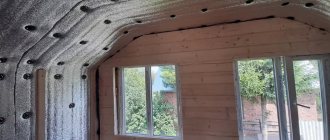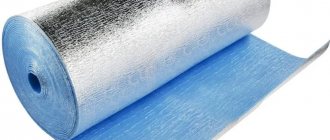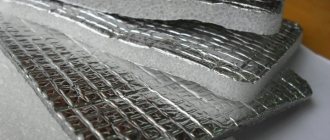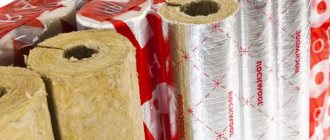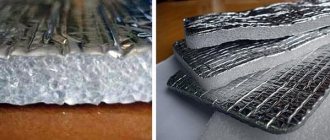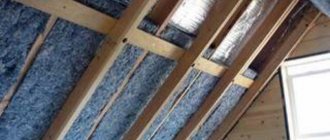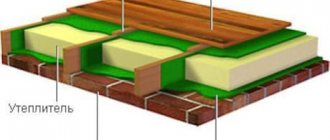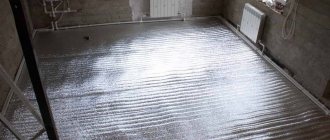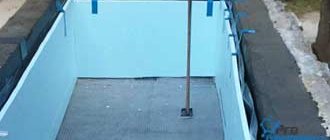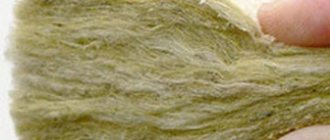SHARE ON SOCIAL NETWORKS
FacebookTwitterOkGoogle+PinterestVk
Today, the construction market offers a large selection of insulation materials. Many manufacturers are constantly improving their technical performance, which is due to the tightening of customer requirements in matters of energy saving of buildings and structures. One of the best representatives of reflective thermal insulation is foil penofol, which is characterized by universal properties.
Foil penofol is a modern material that is used as insulation
What is the name of foil with insulation: introduction to penofol
Foil penofol is a registered brand. It is represented by a multilayer material that belongs to the class of reflective thermal insulation. The name of insulation with foil is derived from two words: “foam” - from expanded polystyrene and “foul” - from foil.
Penofol consists of foil and expanded polystyrene foam
Its main purpose is to protect building structures from wind loads, moisture, steam, and condensation. Penofol is a universal material that combines the qualities of heat, sound, steam and moisture insulation. The basis of such a heat insulator is polyethylene foam with closed pores, which are 95% filled with air, thereby eliminating heat transfer. This polymer layer can be of different thickness, structure and density.
Polyethylene is covered on one or both sides with aluminum foil, which is pre-polished to achieve maximum reflectance. The material is applied by heat welding, which ensures reliable adhesion of the foil to the polyethylene.
Important! As a result of using foil foam, it is possible to reduce the cost of heating rooms in winter, and in summer, slow down the heating of the house.
Briefly about the manufacturer
Penofol is a brand name for foamed foil polyethylene. In Russia it has official permission for its production.
There are analogues of penofol on the market, but they are produced under other names: Ecofol, Isoflex, Izolon, Tepofol. When purchasing, you need to require documents for the material confirming its quality, otherwise you can buy a fake, which, unfortunately, is present on the market.
With the help of foiled penofol, it is possible to retain heat in the winter and, thereby, save on heating, and in the summer, to minimize the heating of the house.
The principle of operation of foil insulation called “penofol”
Having decided on the question of what foam rubber with foil is called, it is necessary to understand the principle of operation of foil penofol. It is based on the functioning mechanism of a simple thermos. This development is associated with the name of the Scottish scientist in the field of chemistry and physics James Dewar, who conducted a series of experiments at the beginning of the twentieth century.
Penofol first accumulates thermal energy and then slowly releases it
Scientists have found that any substance can resist the transfer of heat. It accumulates heat waves, while accumulating energy. After some time, oversaturation is observed, leading to the fact that the material begins to give off heat.
The scientist then identified a number of materials that could reflect thermal energy rather than store it. These substances include polished aluminum. When thermal waves reach the surface, they are reflected from it by 99%, which indicates excellent thermal conductivity. Such substances must be supplemented with other materials that perform the function of “thermal barriers,” which can be foamed polyethylene.
From the above, it becomes clear what penofol is and how it works. Due to the fact that the air cushion in the form of foamed polyethylene is covered with a reflective element (foil), the material is able to retain the heat it receives from it for a long time. This is because polished aluminum does not store heat, but rather transfers it to another material that can store it. Thanks to its unique features, foamed penofol copes with this task in the best way.
Main brands on the modern market
Manufacturers of domestic foamed polyethylene: Tepofol, Vilaterm, Izolon, Energoflex (ROLS ISOMARKET), Thermaflex, Polyfom, Penofol, Porilex.
European and American manufacturers of polyethylene foam: DOW, Sealed Air, Pactiv, TROCELLEN, EPE Corporation Group, Alveo.
Every year, up to 185 thousand tons of foamed polyethylene foam are produced around the world. This is a lot. Despite the fact that this market is considered relatively young, the pace of PPE production has already outpaced the production of film, the largest segment of LDPE polyethylene. It is expected that the growth in consumption of this thermal insulator will continue to grow due to the displacement of more expensive substitutes and the use of foamed polyethylene in areas where it was not previously used - in electrical engineering, travel equipment, etc.
Areas of application of foil penofol
Penofol is available in rolls. The thickness of the material is 2-40 mm. At the same time, the same indicator of foil varies between 12-30 microns, which ensures good heat-reflecting qualities of the material. The thickness of the foil layer directly affects the price of penofol per m2. The thinner the thermal insulation material, the lower its price. The most popular insulation is 5 mm thick. The price of foil penofol is 120 rubles/m².
Foil penofol is used for steam, sound, moisture and heat insulation
This material has a wide range of uses. It is used for thermal insulation of residential single- and multi-storey buildings, industrial and administrative buildings, saunas and baths, cold and heated hangars, warehouses, refrigerators, permanent, stationary and mobile trade kiosks and shops, railway cars, refrigerators, vans, pipelines of various types. purpose, heating, air conditioning, ventilation and water supply systems, and is also intended for technical insulation of equipment.
It can be safely used for waterproofing attics, basements, attics and basements. This is reliable heat and sound protection for loggias and balconies. Penofol can be used for finishing external and internal surfaces of walls, ceilings, floors, and ceilings above cold rooms in basements. The material is used to shield heating radiators, insulate and seal window and door systems.
Foil penofol is in great demand among motorists. Using this material, you can perform high-quality noise and sound insulation of the body of a car and truck.
Foil penofol: what are its strengths and weaknesses
This type of reflective thermal insulation has distinctive advantages that are associated with the universal characteristics of foil foam. Due to its small thickness, the material is able to provide reliable heat, sound, moisture and vapor insulation of the room. It is characterized by good strength, as a result of which it is resistant to deformation and mechanical damage.
Penofol has many positive features
Penofol is an environmentally friendly product that does not emit harmful substances into the atmosphere. It is odorless and does not contain or create dust particles. It can even be used to store food. The material is able to provide room protection from beta rays, which is especially valuable in various enterprises or in unfavorable areas.
Foiled penofol can be used as insulation when performing repair work both outside the building and inside the building. Due to its low vapor permeability, there is no need to install an additional vapor barrier layer when laying it. The material is characterized by a high degree of sound insulation, so it is used to protect workshops and residential buildings from acoustic and structural noise.
Due to the fact that penofol belongs to the class of fire-resistant materials, fire safety is ensured when using it. However, during the combustion process it causes high smoke levels in the space.
Distinctive features of foil penofol
Penofol is easy to transport due to the fact that it is produced in rolls of small width. When installing this insulation there is no need to use special tools. The material is fixed to the surface using an adhesive composition. The most effective result is achieved when using self-adhesive foil foam.
Penofol has no odor and is also environmentally friendly
Important! To install foil foam foam, you should not use nails or other fasteners, since such an installation will negatively affect the thermal insulation qualities of the material.
Penofol is characterized by a small thickness, but it ensures the proper level of thermal insulation, which is achieved by using thicker thermal insulators. This characteristic allows you to save internal space when laying penofol in the room itself, which is especially valuable when it is in short supply. The thin structure of the material also eliminates the possibility of rodents setting up their burrows inside the insulation.
Foil penofol 5 mm (and other thicknesses) is characterized by a long service life, which is at least 50 years. This material is also capable of providing protection from the harmful effects of electromagnetic radiation, reducing its field level tens of times.
Despite the excellent advantages of this insulation option, it is characterized by a number of disadvantages. Penofol has a soft structure, for this reason it is not recommended to be used for insulating walls that will be plastered or finished with wallpaper. In addition, contact of the aluminum layer with paint or varnish often causes damage to the material. Even the slightest mechanical impact can damage its integrity.
The material can be used for both interior and exterior work
Roof insulation with penofol - convenient, effective, affordable
Roof insulation with penofol. If you are looking for high-quality and inexpensive insulation for arranging a roof, attic, attic or ceiling, then our company will be happy to offer you foil Penofol - a new universal thermal insulation product that has a lot of obvious advantages.
By purchasing Penofol for a roof, you will simultaneously solve several issues at once, because it is not only an insulating material, but also a product that is widely used in waterproofing, soundproofing and vapor barrier of modern buildings.
Thus, by correctly installing reflective foil and polyethylene foam, you have the opportunity to create a high-quality and energy-efficient attic and at the same time receive significant savings in time, effort and money.
The main modern insulation materials are in many ways inferior in characteristics to Penofol, so our store’s assortment includes different types of material based on foamed polyethylene, but for roofing work there is no alternative to Penofol A-05, and for finishing the ceiling surface indoors, type C can be used .
Roof insulation with Penofol will allow you to achieve excellent results with minimal time and financial costs. When building a summer house, cottage, laying in the roof and on wooden floors will provide you with a comfortable temperature inside the room at any time of the year. Insulation with Penofol is carried out in attics, installed in attics, verandas, gazebos, summer kitchens, etc., and Penofol is also installed on the ceiling, thereby ensuring reliable thermal insulation of the structure of a house or garage.
- You don’t know how to attach Penofol?
- How to glue Penofol to penoplex?
- Is Penofol harmful to health?
- How to fix Penofol to the ceiling?
- Which side should I lay it on?
- Penofol or Tepofol, which is better?
Our production specialists will be happy to advise you on any questions, tell you about roof insulation with penofol, installation and technical characteristics of our products. Reflective insulation is suitable for construction work on any residential, commercial or industrial site. Heat, hydro, noise and vapor insulation for roofing using reflective insulation in accordance with GOST is in great consumer demand today, since this unique insulating material is characterized by such important consumer qualities as:
- strength – resistant to mild mechanical stress;
- reliability - firmly attached to the false ceiling in flat roofs;
- practicality - performs several functions at low cost;
- multifunctionality - has the effect of insulation and vapor barrier;
- versatility - can be used in any rafter structures and roofs;
- resistance to temperature changes, ultraviolet radiation and other negative factors
- ease of installation - just nail the penofol with a stapler and glue it with tape;
- Penofol insulation is very economical and does not require large installation costs;
- durability – Penofol service life is up to 50 years;
- environmental friendliness - absolutely environmentally friendly material.
Insulating a private building, country house, or any other type of premises with Penofol does not require special training, complex tools or additional installation elements and specific tools. The main thing is to provide a ventilated gap on the foil side of at least one centimeter and seal the joints with aluminum tape LAMS.
Differences between penofol insulation and other heat insulators
Heat is transferred from one substance to another in three ways: through heated air, through radiation, and due to thermal conductivity of materials. Most thermal insulation products interfere with one of the options for transporting heat. Foiled penofol is characterized by a complex effect, which is achieved due to the fact that foamed polyethylene does not allow convection, and the thermal reflection of aluminum foil reaches 97%.
In terms of technical characteristics, penofol can be compared with a heat insulator such as izolon. The last option is sheet material, the thickness of which is 12-50 mm. However, the cost of such a heat insulator significantly exceeds the price of penofol. In addition, isolon is able to accumulate heat, and penofol reflects it.
This insulation is also easy to install (this especially applies to self-adhesive options). It does not require the construction of vertical posts, which are necessary when attaching mineral wool. The cost of penofol is the lowest compared to other thermal insulator options.
The advantage and distinctive feature of penofol is ease of use
Foil penofol: technical characteristics of the material
Foil penofol is able to withstand temperature fluctuations from -60 to 100 ° C, which expands the scope of its use. The thermal reflectivity of the material reaches 97%. The thermal conductivity coefficient is in the range of 0.037-0.052 W/m*C, which depends on the operating conditions.
This suggests that 1 cm of polystyrene foam can provide the same thermal insulation as 4 cm of polystyrene foam. The sound absorption level of the material is 32 dB, which creates a good noise insulation barrier. In addition, penofol can dampen vibrations, which is especially important when insulating metal surfaces.
Important! The thermal transfer resistance of regular or self-adhesive foil foam foam is 10 mm higher than that of a 50 mm thick brick wall.
The specific gravity of the material is 44-50 kg/m³, which is much less than that of mineral wool. An important characteristic of penofol is its low level of moisture absorption. The water saturation threshold is 0.35-0.7%. The elasticity coefficient varies between 0.26-0.39 MPa. The vapor permeability of the material reaches 0.0001 mg/mhPa, making it a good barrier to evaporation. The thermal conductivity of foil insulation is 1.95 J/kg*C.
Foil penofol can withstand temperature changes ranging from -60 to 100 °C
Penofol is produced in the form of a roll material, the length of which is 5, 10, 15, 30 and 50 m. The width of the product can be in the range of 0.6-1.2 m. Standard thickness is 2, 3, 4, 5, 8 and 10 mm. For some options this figure is 40 mm.
Characteristics of regular and self-adhesive penofol
Depending on the manufacturing technology of the heat insulator, there are three main types of penofol: A, B and C. The first group is represented by a polymer insulating material with one-sided foil. It can have a thickness from 2 to 40 mm. The width of penofol is 40-120 cm. This type of insulation is often combined with other material options in the form of mineral wool or glass wool; it is often used for thermal insulation of floors.
Penofol type B has double-sided foil, which achieves a higher insulation effect. The thickness of the material is 2-10 mm, width - 58-200 cm. This version of the reflector is used for thermal insulation of load-bearing structures of walls, floors, waterproofing of the attic and basements.
Helpful advice! Laying insulation B under the roof will create an obstacle to hot air entering the premises in the hot summer.
The most popular types of penofol include products of types A, B and C
Penofol type C is a self-adhesive version of insulation, which is covered with polished aluminum foil on one side, and on the back there is a moisture-resistant adhesive composition, covered with a protective film, which prevents adhesion. This material can be used for thermal insulation of any surface, which makes it possible to significantly save time. Penofol C is especially preferable for finishing inconvenient areas of the structure. Before use, the material is cut into elements of a certain size.
Helpful advice! For conventional insulation, the base is white, but for penofol 2000 type C, A or B it is blue, which indicates a cheap analogue of the standard material with lower characteristics.
Other types of polymer insulation with foil
There are other types of penofol that are in less demand. Type R material has one-sided foil on which a relief pattern is applied. This option can be used not only as insulation, but also as a decorative element to decorate the structure, as demonstrated in the photo of the foam foam used to decorate the walls of the premises.
Related article:
SML panels: a modern and multifunctional analogue of drywall
Description of the material, advantages and features. Scope of application, prices and customer reviews. Painted magnesite plate.
Insulation grade M also has one-sided foil coating. The other side of the material has a relief surface. It is advisable to use penofol insulation of this type for finishing places where it is necessary to create an air layer, which is often required when arranging a loggia or balcony. In this case, the ribs on the surface should be located vertically, due to which a good level of ventilation of the structure will be achieved.
Products of type R are equipped with a relief pattern and one-sided foil
Highly specialized types of penofol include materials such as ALP and NET. The first option has a coating of polyethylene laminated film, which ensures high reflective properties of the material, increased corrosion resistance and good dielectric properties. This type of insulation is typical for finishing incubators, and is also ideal for a “warm floor” system.
Helpful advice! You can check the quality of the insulation by looking through it into a bright light, which should reflect all the spots, stripes and unevenness of the material.
Penofol type NET is similar to option B, but is produced in narrow roll strips, making it convenient to use as an insulator for pipelines, heating mains and air vents.
Among the new products we can highlight perforated penofol. A distinctive feature of the material is its ability to “breathe”, which is achieved due to the presence of a large number of micro-holes. This option is most appropriate to use for thermal insulation of wooden structures.
Penofol type M is suitable for insulating loggias and balconies
How to properly lay foil insulation on the floor
To lay foil insulation on the floor, you must first prepare the base, on which all irregularities, defects and cracks must be eliminated. Then the surface is treated with a soil solution.
Helpful advice! To achieve better thermal insulation properties, many experts recommend laying foam plastic 7-12 cm thick under foil insulation on a concrete floor.
When using a type A heat insulator, a thin, uniform layer of penofol adhesive is applied to the base. Particular attention is paid to the edges of the material, which must be carefully treated with adhesive. Next you should wait 10-60 seconds. for the glue to dry, which will contribute to its better adhesion. After this, the insulation is fixed with little force, performing careful smoothing.
For indoor floor insulation, a more convenient option is penofol C 10 mm. To install the material, it is enough to remove the protective polyethylene film from its inner surface. The insulation must be laid in such a way as to ensure that it overlaps the walls by 5 cm. Penofol strips should also not overlap. Protruding areas should be removed using a construction knife. The joints must be sealed with insulating aluminum tape.
Foiled penofol is suitable for the “warm floor” system
Important! When deciding which side to lay the foil insulation on, you should remember that the foil part of the insulation should face the inside of the room, while the opposite side is glued to the floor. In this case, reliable vapor and noise insulation is ensured.
How to lay insulation for a “warm floor” system and on the ceiling
To install a “warm floor” system, two methods of laying penofol are used. The first involves installing joists on the insulation. This option is advisable to use if a wooden floor is mounted on a heat-insulating material. The logs should be laid along such a base on top of the heating elements.
When installing a heated floor under the tiles, the base is covered with foil foam, which is fixed to the concrete surface with glue. Heating elements are mounted on it, which are covered with reinforced mesh and then filled with concrete mixture. For this option, it is recommended to use foil penofol "Leroy Merlin" type ALP.
The laying of electrical cables over foil foam is carried out in a protective corrugation. This also applies to radio cable and telephone wire. This safety measure is explained by the fact that foil is a good conductor.
Foil penofol types A and B are suitable for insulating ceilings
Let's consider how the ceiling is insulated using such material. First of all, self-adhesive foil penofol 5 mm is fixed to the base surface. Wooden slats are screwed onto it to create a frame for type B insulation. It is attached to the bars using screws or a construction stapler. If it is necessary to install a third layer, the process is performed in a similar way.
Cross-linked polyethylene manufacturing technology
This material can be obtained by two methods - radiation and chemical. Let's talk about them in more detail. The chemically cross-linked foam material is produced under high pressure. During the manufacturing process, special antioxidants and reaction stimulants are added to the composition. Next, the base for polyethylene in a thermoplastic state is straightened and formed in accordance with the requirements for the finished product.
In turn, reactors in the form of peroxides act to create cross-links and disintegrate under the influence of high temperatures. In addition, cross-linked foamed polyethylene foil undergoes a reaction of substitution of hydrogen atoms with unsaturated carbon elements. This process makes it possible to form a spatial structure of bound radical elements, which in practical use results in high tensile strength of the material. In the application of radiation technology, the connection of molecules occurs not under the influence of a chemical reaction, but under conditions of a directed beam of energy.
Read with this
- Foil insulation: types, properties and possibilities of use
- Insulation of a veranda in a wooden house
- Insulation for protecting pipes, made of foamed polyethylene (thermal insulation)
- Isover thermal insulation overview
- Underlay for insulation on the ceiling
- Insulating a balcony with panoramic glazing: useful to know
- Mineral wool, its characteristics and insulation composition
- Properties and types of dowel mushrooms for fastening insulation
- Insulation of a concrete floor in an apartment
- Polyethylene: properties and applications
